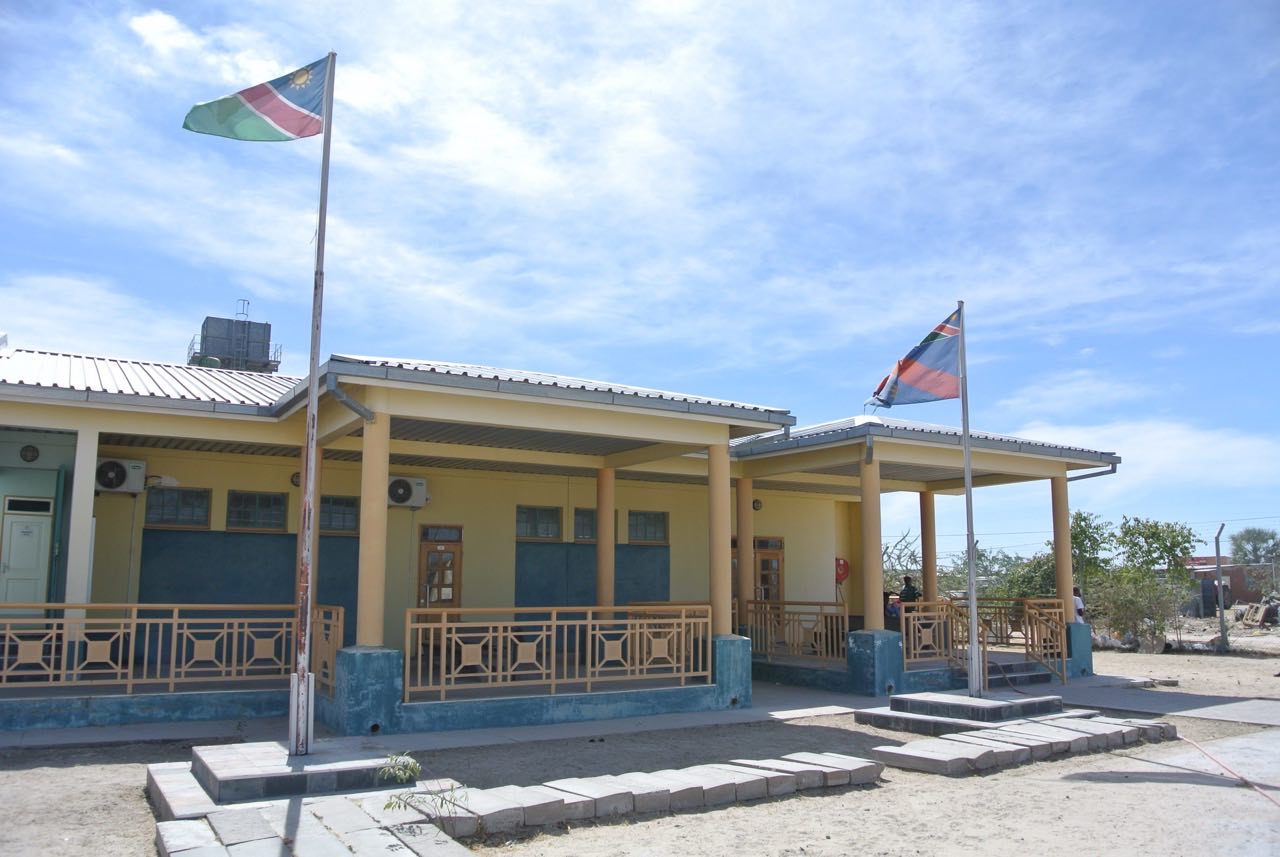
15 Sep A mysterious dead hand driving Namibia’s poaching
After a two-year investigation, John Grobler exposes the totem-based networks facilitating transnational rhino horn smuggling and defeating the criminal justice system’s pursuit of suspects
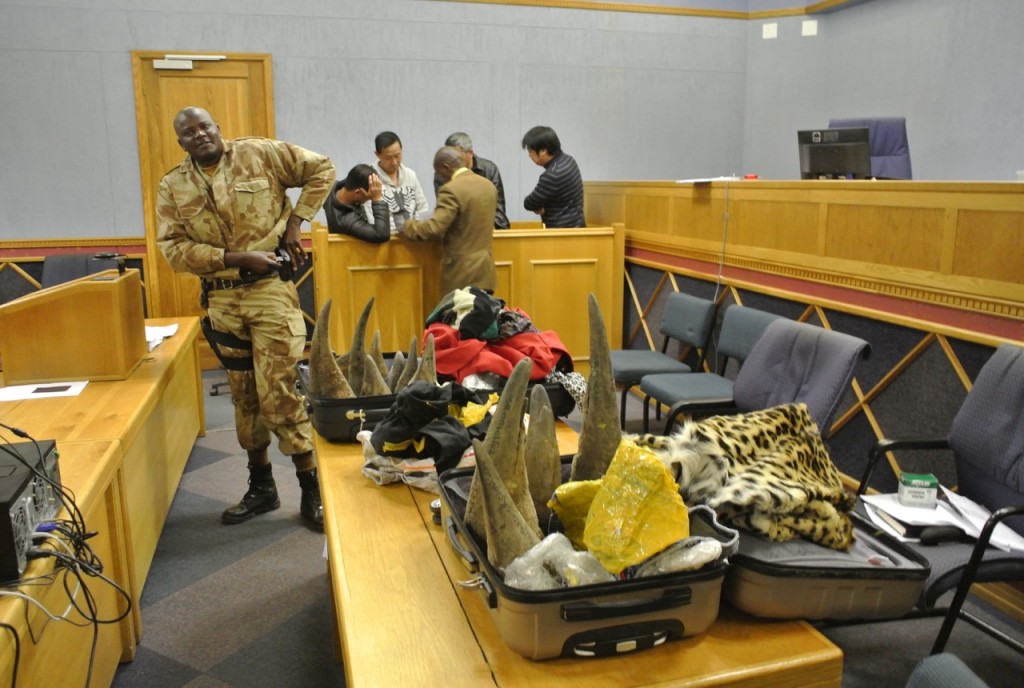
Fourteen horns and a leopard skin, confiscated during the March 2014 bust at the Hosea Kutako International Airport. Zambia was operationally key to the syndicate’s smuggling attempts
A mysterious, tribal totem-based network of politicians, top officials, policemen and former soldiers, dealing with a web of Chinese, Zambian and Congolese smugglers in anything from hardwoods to ivory, rhino horn and pangolins, has emerged at the centre of resurgent rhino poaching that may have killed off as much as 20% of the world’s remaining critically endangered black rhinos in Namibia.
A two-year-long investigation also brought to light that rhino poaching in Namibia may be far worse than suspected, and had started as long ago as 20 years, if not longer.
A culture of secrecy, lack of access to official information and cooperation has made it difficult to produce hard evidence, but the circumstantial case is compelling.
In nearly every case investigated, certain common elements kept emerging: clan affiliations, military and political connections, dealing via Zambia-based intermediaries with Namibian-based Chinese buyers and smugglers.
In line with tribal totem practices, these connections act like a mysterious dead hand by seemingly frustrating and slowing down Namibia’s criminal justice system’s pursuit of suspects, both at lower and higher levels in their respective syndicates.
Since 2014 poaching cases have been routinely delayed, repeat offenders routinely granted bail and police too efficient at rounding up poachers sidelined to dead-end desk jobs or pushed into early retirement. At least one prosecutor is officially under investigation for lying to the police about when a specific case was to go to court.
It is also part of a general decay in the the administration of justice in Namibia’s lower courts, where most poaching cases are handled.
“It’s getting so that [when] we hear about an armed robbery, we just call the suspect and tell him to hand himself over,” said one senior police officer. “And they do it because they know they will get bail within a month.”
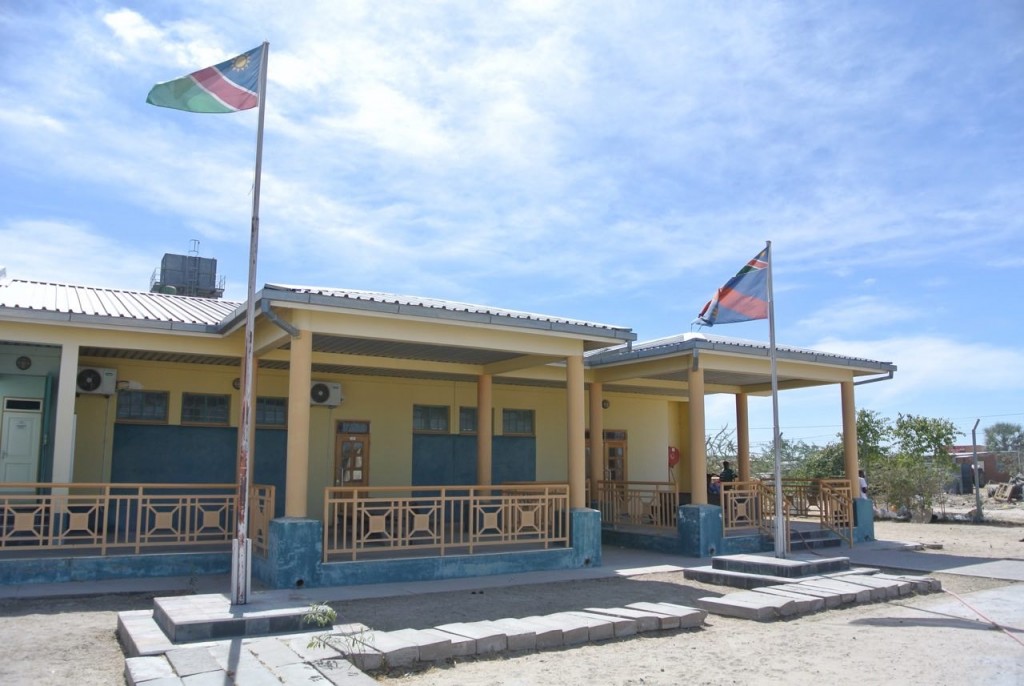
The Okahao magistrate’s court, where 22 suspects are appearing on rhino poaching charges. Photo: John Grobler
The Aakwambahu clan
At the heart of it lies a deep tribal secret of totem-based networks, arranged in a hierarchical fashion around the the Aakwambahu totem, meaning “people of the locust”.
The Aakwambahu clan is the most powerful of the clans of the Ondongwa and Ogandjera sub-clans of the Aawambu people of north-central Namibia. It cooperates with other totem-clans such as the Aakwantu (“bow and arrow”) of the Uukwaludhi people and Aakwankala (“indigenous”) hunting clans of southern Angola’s Uukwanyama people.
Among the Ogandjera, who make up the vast majority of poaching suspects, the Aakwambahu and Aakwaniilya (“corn”) also cooperate closely. This could be seen most clearly at the Sheya Uushona lodge, where all the staff are Ndonga but the chiefs Ogandjera. (See “‘Trojan horse’ of Namibia’s rhino poaching crisis“)
The totem system extends across tribal and national lines into Angola and Zambia, and has emerged as a central theme in resurgent poaching that has devastated the critically endangered black rhinos in Etosha National Park and the neighbouring Kunene region.
Depending on the matriarchal lineage, an Aawambu child automatically becomes a member of a specific clan serving as a network that protects, educates and interacts with that individual. Complete strangers of the same totem clan will automatically cooperate with each other, wherever they find themselves, according to Dr Shekutaamba Nambala, a theologian who has intensively studied the Aawambu totem system.
The poaching syndicates are also organised along cultural age-group lines: teams of two poachers, one younger (20s) and one older (30s or 40s), who typically receive R15,000 to R25,000 per dead rhino.
Weapons are supplied to the mostly impoverished poachers, with syndicates often “renting” a rifle for large sums, a factor that has complicated ballistic evidence. Recently automatic weapons equipped with silencers have become increasingly common, with both R-5s and AK-47s confiscated from poachers.
The rhino horns are then smuggled out of Namibia with the help of wardens, officials and corrupt police, who pocket anything between R50,000 and R150,000 per set of horns.
The real money, however, is made by the brokers acting between the regional “collectors” and the Chinese buyers, with anything up to R5-million per rhino killed split between them, their Aakwambahu seniors and their political connections in high places.
The Aakwambahu (also known as the Kwambaku) network reaches into the top ranks of the Namibian government, which is dominated by people from the Ombalantu and Okahao areas in the Omusati region.
The majority of poachers arrested so far are from the southern Omusati region around Okahao, all coming from settlements like Onamatanga and Uutsathima inside the Sheya Uushona conservation area bordering on north-western Etosha. Of 76 suspected poachers questioned in this area, 17 are currently facing charges in the Okahao court of poaching protected game. (See “The epicentre of Namibia’s rhino poaching“)
Namibia’s founding president, Sam Nujoma, who still maintains a residence in Okahao, is known to be an Aakwambahu. The clan includes dozens of notable businessmen and several current and former ministers.
These include Okahao business tycoon David Sheehama, also known as David Shivute of Kambwe Trading, a company contracted to rebuild the northern Etosha border fence at a cost of R2-million per kilometre.
Ogandjela chiefs Vaino Kalimwe and Sakarias Shikongo of the Sheya Uushona conservancy on Etosha’s northern border are also Aakwambahu.
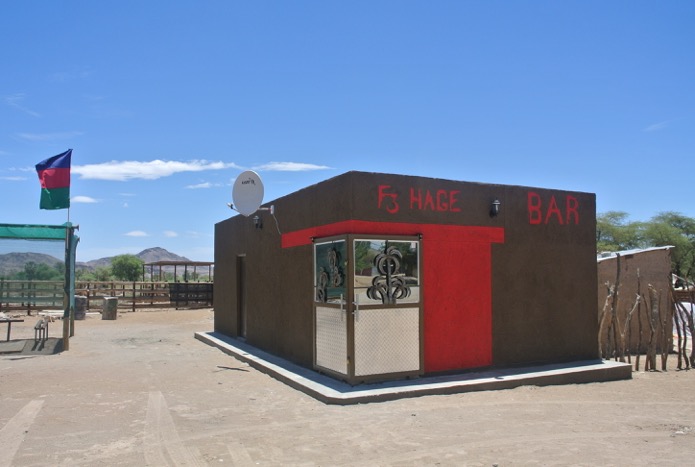
Rhinopreneurship? A new bar built in Sesfontein, shortly after the extent of poaching in the southern Kunene region became apparent. Photo: John Grobler
The main local economic driver is a culture of “rhinopreneurship”: the organised poaching of rhinos to finance new or failing business ventures, run by syndicates of cultural age-groups of men in their 20s, 30s or 40s.
Income from rhino poaching is often used to acquire flashy cars and clothes, as in the case of Mox Namwandi, arrested two months ago and believed to be an Aakwambahu as well. (See “Bling king accused in Namibian rhino poaching“)
Although nearly 60 poachers have been arrested since late 2012, only one has so far been convicted in the Opuwo magistrate’s court. At least five of the Okahao suspects in court have been caught again with rhino horn subsequent to their release on bail, court records showed.
Mounting but hidden losses
That poaching losses are far worse than officially acknowledged has been an open secret for some time: many carcasses discovered since police patrols were re-instated in Etosha National Park in 2014 were older than 10 years, the Ministry of Environment and Tourism (MET) has acknowledged.
And those losses have been mounting: a block count in August in Etosha found 33 previously undiscovered black rhino carcasses, 25 of which were killed by poachers, Major-General James Tjivikua of Nampol confirmed.
Six more black rhino carcasses were discovered in the Palmwag tourism concession area in neighbouring southern Kunene area during the same period, Tjivikua told local media. MET officials have declined to comment so far, but are investigating.
This brings total losses of Namibia’s critically endangered black rhinos, which comprise 40% of the world’s surviving population of about 4,800 specimens, to nearly 200 animals now. Many carcasses were too old to be dated accurately, the MET has admitted.
Losses might in fact be higher: no block count was done in the Manketti area where dozens of post-breeding bulls have been relocated, often for the purpose of commercial hunting. Namibia is currently auctioning off three such bulls to sports hunters.
And while 2012 was generally considered the year zero for rhino poaching in independent Namibia, the full truth appears far murkier and obscured by political dust kicked up by those involved.
“It started when Sam Nujoma in the early 1990s said people must use the natural resources to help themselves and [former minister of environment and tourism] Nangoloh Ithete was charged for illegally catching ostriches to stock his and [former justice minister] Ngarikutuke Tjiriange’s Omusati farm,” said a social historian and insider of the Uukwanyama royal clan who did not want to be named.
“The people literally took him for his word and started helping themselves to the game”, starting an avalanche of poaching that has denuded northern Namibia of nearly all its large game.
The nature of the syndicates constituted the re-emergence of the deeper cultural bonds between UNITA and the Ovimbundu and powerful SWAPO people, he explained. It is an oft-overlooked fact of history that prior to 1975 and the overthrow of Portuguese colonial rule, SWAPO and UNITA collaborated closely: Nujoma and former UNITA leader Jonas Savimbi famously shared a bed in Lusaka once.
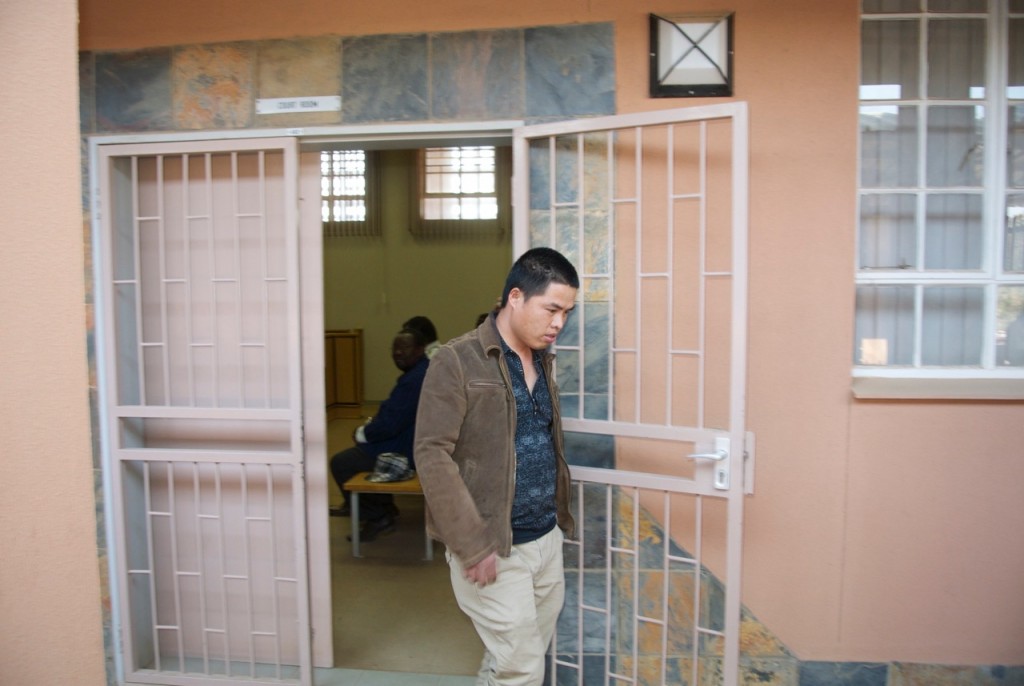
Deijan Xu, the only Chinese suspect so far to be convicted of dealing in rhino horn, outside the Opuwo court room. Xu received a fine of R20,000 and appears to have left Namibia since
The Zambia-China link
Zambia, and especially its links with Namibian-based Chinese businessmen, has emerged as a major regional link to organised poaching and trade in exotic hardwoods between Namibia, Angola and the Democratic Republic of Congo’s southern Katanga province.
Zambians from the economically neglected Western Province are widely known to be responsible for the resurgent elephant poaching in south-western Angola, Caprivi and Botswana. The Zambians in turn are closely linked to the Ndonga people of Ovamboland, and share the same cultural totem systems. Of late, their link to Namibian rhino poaching has become even more apparent.
In April, Zambian police in Mongu, Western Province, arrested two locals and a Namibian for being in possession of two black rhino horns. They remain in custody, unlike most Namibian suspects who routinely obtain bail, often to return to their dirty work immediately afterwards.
In early May, Nampol’s anti-poaching unit arrested Twakutakumwe Mpya and a certain Kalunga after their tracks were found inside Etosha. Fresh rhino horns, illegal ammunition and a .303 rifle were found in their possession. The rifle led the police to Zambian national Festus Mazuvu, a senior manager at regional electricity distributor Nored in Ondongwa.
Mpya pointed out where he had stashed the horns as well as the carcass in the Etosha to the police, who subsequently discovered two more carcasses, one fresh, in the same area, according to sworn affidavits by police in the criminal docket opened in the Muzuva case.
The Mongu and Mazuvu syndicate’s arrests have now led investigators back to Okahao in the Omusati region in Namibia, and to a prominent local businessman, a well-placed legal source said.
Earlier this month, Zambian-registered professional hunter David Chihinga Kalwizi was picked up by the police in Otjiwarongo after a black rhino was poached at the private Erindi game reserve in central Namibia.
Police sources said Kalwizi had booked into the lodge and hidden two firearms in the bush before booking out – and returning with another Zambian, a Namibian and an Angolan accomplice to kill a black rhino a few days later.
Kalwizi, Zambian national Ndala Mukisi, Angolan Franco Mapulanga Liswaniso and Brian Mandjolo made a brief appearance in the Omaruru magistrate’s court and were remanded in custody until their next appearance in November. Nampol’s Protected Resources Unit said they were now looking for a Congolese in whose shack in an Okahandja squatter town the horns were recovered.
Meanwhile, Marshal Nakutiwa, a former policeman now employed by state-run Namibia Wildlife Resorts, was arrested with an accomplice in Rundu for possession of two fresh rhino horns they were trying to sell.
Nakutiwa, aged 48, and his accomplice, Jeremiah Mukuve (30), were remanded in custody. Nakutiwa, a nephew of Regional Government and Housing Minister, Lieutenant-General (retired) Charles Namholoh, was recently transferred out of Etosha because of his suspected links to poachers, sources close to the official investigation said.
Although two fresh rhino horns were confiscated from them, MET is yet to find the carcasses from which those horns originated.
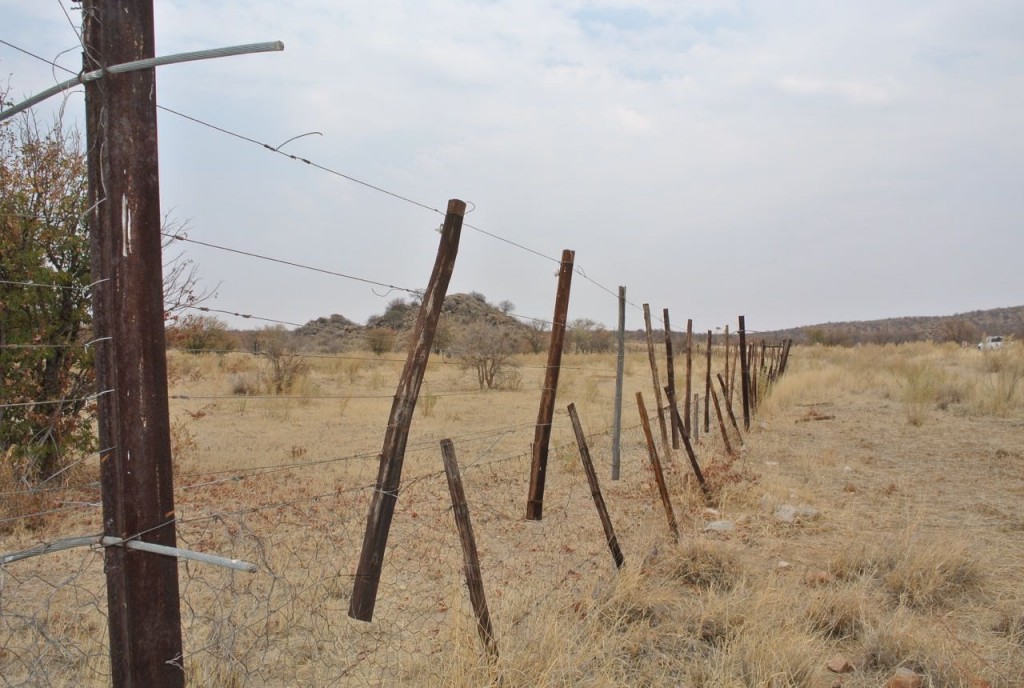
Free for all: the state of the fence on the western boundaries of the Etosha National Park. Photo: John Grobler
Old pipelines, fresh blood?
It has emerged that rampant poaching in Etosha appeared to have started as long ago as in late 1989, with another major poaching spree occurring in 1996 as the current ruling SWAPO party started removing anti-poaching teams comprising their former enemies of the colonial-era police and soldiers from their positions in the national park.
News of this – as in the more recent poaching – was suppressed by a powerful cabal of politicians and officials in the newly independent Namibian government, a two-year-long investigation has showed.
In 1989, a group of Oshiwambo and Otjiherero businessmen from Oshakati and Opuwo were fingered for poaching 30 rhinos in Etosha during the run-up to Namibian independence elections.
A former Etosha warden who was part of the 1989 investigation said a well-known businessman from Oshakati (name withheld) had emerged as the main suspected poacher, but no charges were ever laid because of the prevailing political circumstances during the run-up to the elections.
The current resurgence in poaching “… is exactly how it was back then as well”, he said.
In 1996, Gerrit van Wyk, a South African-born Etosha warden tasked with looking after a group of white rhinos that had been relocated to the Sandveld area in the national park, was sent to the Noordoewer border post to sign gun permits.
In an interview, he said he had discovered 27 rhinos had been poached when he returned to his Etosha post three months later.
When he was again ordered to Noordoewer the next year, he refused to go – and was summarily dismissed, although MET claims he resigned. Several other former wardens confirmed this incident – but apart from one report in a local daily newspaper, it was totally covered up.
The resurgence in the poaching since 2012 echoes the rampant poaching in the 1980s, which the 1996 Kumleben Commission of Inquiry found deeply involved the former South African Defence Force’s Military Intelligence Directorate (MID) and former rebel movement UNITA of Angola.
The MID used a front company, Frama Inter-Trading based in Rundu and run by Sergeant-Major José Lopes (“Lops”) and Johannesburg-based businessman Tony Viera, to move wildlife contraband and diamonds to Chinese businessman Chong Pong of Lubumbashi and Lusaka in Zambia.
After disappearing into Mozambique in 1989, “Lops” – now in his early 80s – has returned to Calais, the small Angolan border town across the Kavango river from Rundu, sources in the local Portuguese community confirmed.
Current smuggling routes are similar to those in the 1980s, when most rhino horn and ivory was smuggled out via Zambia, DRC and Burundi by the apartheid-era MID and their Portuguese “sub-contractors” like Tony Viera and Chinese buyers like the Pong family, using scrap metal to hide the contraband.
In 1991, a former National Central Intelligence Services director of counter-intelligence, George Iita, was arrested along with four Portuguese and a Katima Mulilo-based doctor for trying to sell 972 elephant tusks to a police informant. Like most such seizures, the main players were Portuguese of Angolan descent.
This commercial link appeared to have re-surfaced recently as part of a long-existing “Portuguese mafia” known for their diamond-smuggling activities in and around Port Nolloth, just across the southern Namibian border and its rich diamond fields. This syndicate is linked via Namibian players in turn with the Chinese in Zambia, which is also a major regional hub for unlicensed diamond trading, wood and other wildlife products.
All pipelines run via Zambia
A roaring but largely illegal Chinese trade in hardwood and other wildlife products from the DRC and Zambia forms an integral part of the rhino horn and ivory smuggling, the Oxpeckers investigation has established.
Zambia’s prominence in smuggling pipelines first emerged during the trial of four Chinese arrested in March 2014 for being in possession of 14 rhino horns and a leopard skin at the Hosea Kutako International Airport.
During the trial of Hui Wang (41), Pu Xuexin (51), Li Zhibeng (55) and Li Xiaoling (31), which started in 2014, it emerged that Pu had recruited both Lis from their rural Nan Tong village at the mouth of the Yangtze River. Evidence in court showed Pu, Li and Li had entered Namibia in early March 2014 by road after flying to Lusaka from Shanghai via Johannesburg first, spending only a day in Zambia to obtain tourism visas for Namibia. (See “Inner workings of a Chinese poaching syndicate“)
There are several daily flights between Johannesburg and Windhoek, and the group’s detour of several days and thousands kilometres suggested that Lusaka was operationally key to the syndicate’s smuggling attempts.
Hui, whose Otjiwarongo house they had stayed in shortly before being arrested in Windhoek, also entered Namibia the same way – but his passport does not display an entry stamp for Namibia, suggesting he may have used a second, false passport.
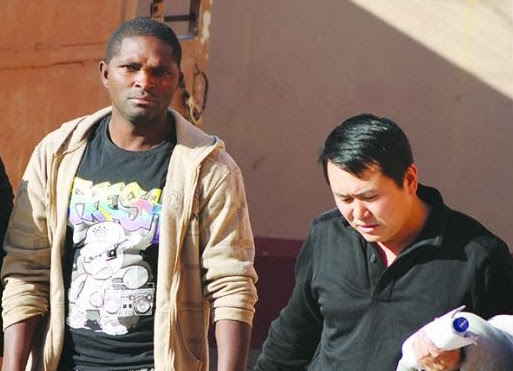
Hou Xuexin (right) and Congolese suspect George Mashala after they were arrested in Windhoek in 2012 for dealing in ivory. Photo: The Namibian
Hui and another key suspect, wealthy Chinese businessman Xuexeng Hou, run a wood-exporting business in Zambia, it was confirmed. Hui in late 2013 tried to convince a local carpenter to build him tables with legs thick enough to conceal a rhino horn, said a carpenter said in an interview.
Hou for his part has a string of wildlife-related offences on his record, including criminal convictions for theft in 2007 and 2010. He is currently out on bail of R100,000 on four charges of dealing in wildlife contraband and stolen crocodile skins. Like Hui, Hou has been doing business in Namibia since 2005 when he arrived here as an “agricultural worker”, another common factor among the Chinese suspects.
Another major suspected dealer, Walvis Bay businessman Pei Jianing, whose wife for several months operated a shop in remote Sesfontein in southern Kunene, has been under investigation by the Anti-Corruption Commission since early this year.
Two other suspects arrested by the Special Branch a month ago at a Chinese safe house in Windhoek with a large amount of cash and illegal gambling machines were also regular visitors to Lusaka, Chief Inspector Reinhardt Hoaseb confirmed.
The owner of the safe house, Zhang Fuwang, claimed to investigators that he and a former commander of the Nampol Serious Crime Unit, (Chief Inspector) Oscar Sheehama, were partners in a security company looking after Chinese people living in Namibia. Zhang in 2007 unsuccessfully attempted to sue the police and Sheehama for later locking him up for two years for suspected racketeering, High Court records showed.
As a well-known Aawambu saying has it: what eats the bean is inside the bean. – oxpeckers.org
Update: On 16 September 2016, Khomas regional magistrate Alexis Diergaardt found the Chinese poaching synidacte arrested for illegal possession of 14 rhino horns and a leopard skin in March 2014 guilty on two charges each of illegal possession of controlled wildlife products. They were acquitted of a third charge of money-laundering under the Prevention of Organised Crime Act, after Diergaardt found not sufficient evidence had been presented to court.
The four men – Hui Wang, Pu Xuexin, Li Zhibeng and Li Xiaoling, had acted with common purpose to try to smuggle the contraband through the Hosea Kutako International Airport in Windhoek, Diergaardt found.
“They all played different roles, but were together the whole time in Namibia and were associated with each other. All four also handled the four suitcases” that contained the contraband, she said in her verdict.
Diergaardt rejected a guilty plea by the oldest of the four smugglers, Li Zhibing, to try to take the rap for the other suspects.
The four were due to be sentenced on September 23. Namibian anti-poaching laws allow for a maximum sentence of 20 years in jail and/or a R100,000 fine.
Oxpeckers associate John Grobler and editor Fiona Macleod are finalists in the 2016 CNN Multichoice African Journalist of the Year Award for a related investigation – “Caught in the crossfire: how cattle and Chinese mining are killing off Namibia’s black rhinos“.
Related links:
• ‘Trojan horse’ of Namibia’s rhino poaching crisis)
• The epicentre of Namibia’s rhino poaching
• Bling king accused in Namibian rhino poaching
• Inner workings of a Chinese poaching syndicate
